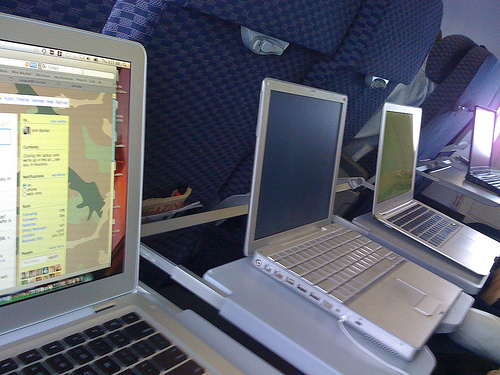Streaming March Madness On The Web

The Northern Iowa bench runs onto the court after their 69-67 win over Kansas in an NCAA second-round college basketball game, Saturday, March 20, 2010, in Oklahoma City. Northern Iowa upset top overall seed Kansas. (AP Photo/Tony Gutierrez)
It’s that time of year again, March Madness, when each basketball team invited to the NCAA tournament is given their shot to make a name for themselves and put their school on the map as a final four contender. Just last night the Northern Iowa Panthers took down the overall favorite and perennial college basketball powerhouse, Kansas. UNI showed up ready to play and made the big shots in this big game, against a big-time opponent. Not to mention, when an upset of this proportion happens, people are watching. The media outlet is quickly changing though, over 3 million computers were streaming the madness each day since tournament play began on Thursday, reported by CBS Sports. Now the inevitable question is how does a TV broadcast company such as CBS manage and afford to pay to stream an event of this magnitude for free to all interested viewers?
From a logistical point of view, making sure the HD stream is available to anyone across the globe comes with the help of the CDN (content-delivery-network) Akamai. Their job is to provide CBS with seamless streaming of their coverage to viewers anywhere in the world. CBS pays to utilize the fiber optic bandwidth infrastructure and data centers that Akamai has already established in internet hot spots around the world. This eliminates costly logistical problems that CBS would otherwise run into if they were to stream the coverage with their own bandwidth. The service contracted out to Akamai is then easily paid back with mandatory 30-second commercials that viewers are required to watch, in order for the player to unlock. Simply put, CBS profits from the increase in online video advertising inventory.

Kansas State and Northern Iowa start their NCAA second-round college basketball game, Saturday, March 20, 2010, in Oklahoma City. (AP Photo/Carlos Osorio)
One other factor, the two year old developer program has allowed for developers to promote the March Madness on demand service and viewers are now able to stream march madness from their HD TV’s, high-speed internet, or mobile device.
Many critics are applauding CBS for their efforts regarding making March Madness coverage widely accessible, as the most recent Winter Olympic’s broadcaster, NBC, required a subscription to view Olympic events live online from Vancouver. CBS’s great work is allowing for everyone to rally behind their bracket picks, and making sure that only the basketball teams are being “upset” throughout the tournament.
March 2011 UPDATE:
To watch the 2011 NCAA Basketball Tournament:

